Tech Report
Clean design planetary mixers
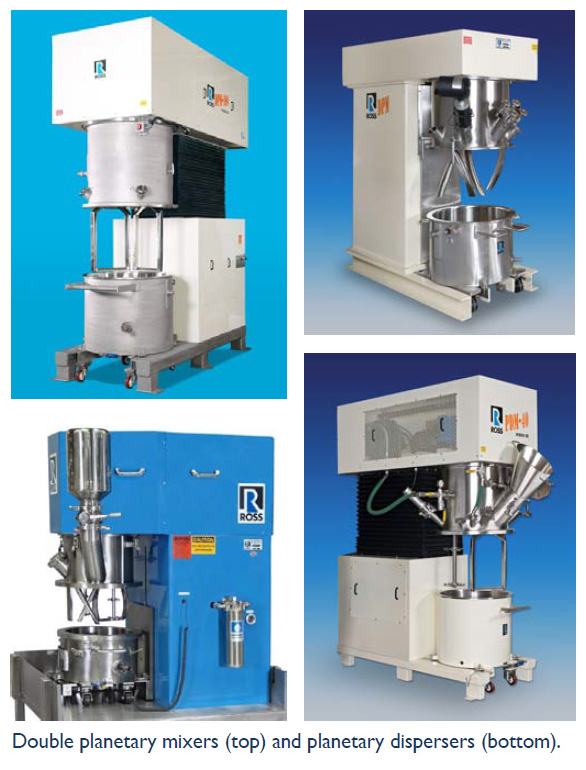
Technology Brief
Contamination in mixing systems can arise from foreign materials in the environment as well as materials within the mixer left from previous batches. In planetary mixers, a number of clean design features are available which help improve ease of cleaning and reduce contamination risks.
Planetary mixer applications
Double planetary mixers and planetary dispersers are commonly used for viscous applications. The agitators rotate on their own axes while orbiting the vessel which imparts a very thorough mixing action regardless of product rheology. Batch components are constantly being recombined and physically moved from one part of the vessel to another until a homogenous state is achieved. Aside from viscous formulations, planetary mixers are also used for dry blending, wet granulation and vacuum drying operations.
Keeping raw materials within the mixing zone at all times is crucial for making consistent high quality blends and lowering cross-contamination risks between batches. Whether in the form of dust, liquid splashes or vapors, traces of product can get into areas of the mixer where they can collect and affect succeeding batches. Below are some clean design mixer features to help improve ease of cleaning and reduce contamination risks.
Well-polished wetted parts. A smooth polish (150-grit or higher) on product contact parts prevents material build-up and facilitates easier clean-up of mixer surfaces.
- Sealed gearbox. A specially fabricated and sealed gearbox protects the drive assembly from all product contact including solvent vapors. If vapors are not a concern, a simpler barrier arrangement around the standard gearbox may be used for protection against dusts and splashes.
- Helical planetary blades. At elevated viscosity levels, certain products tend to climb up the planetary rectangular stirrers and out of the mix vessel. This characteristic migration of batch material reduces mixing efficiency, necessitates intensive clean-up and can even increase contamination risks. Newer design helical blades prevent the climbing issue experienced with traditional rectangular stirrers. High Viscosity "HV" blades offered on Ross planetary mixers feature a precisely angled helical contour which generates a unique mixing action: the sweeping curve firmly pushes the batch material forward and downward, keeping it within the mixing zone at all times. Enhanced control over batch level can significantly improve mixing efficiency and shorten cycle time, while ensuring easier clean-up and product purity.
- Cove plug. This plug is designed to be completely flush with the sidewall and bottom of the vessel. In other words, there are no dead spots in the mixing zone where batch materials can stagnate. It is ideal for non-flowable, high viscosity applications.
- Discharge system. Discharging a viscous batch by gravity can take a long time and even require hours of manual scraping if the product is particularly heavy or sticky. To simplify discharge and clean-up, use an automated discharge system. A platen is lowered hydraulically into the mix can and a specially-fitted O-ring rides against the vessel wall, literally wiping it clean. Product is forced out through a valve in the vessel or the platen.
Ross Planetary Mixers - Sample Configurations
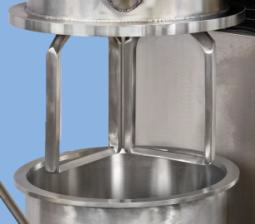
Double Planetary Mixer with Rectangular Stirrers
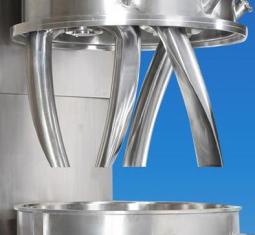
Double Planetary Mixer with High Viscosity "HV" Blades
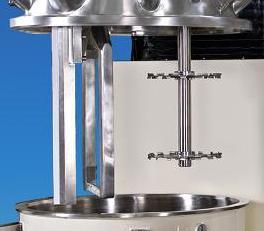
PowerMix Planetary Disperser with Rectangular Stirrer, Dual-Blade High Speed Disperser and Sidewall Scraper Arm
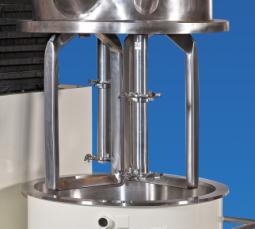
Planetary Dual Disperser with Two Rectangular Stirrers and Two Disperser Shafts
Sample Application: Two-part Silicone
![]()
A Ross Double Planetary Mixer with Discharge System is being used for platinum-cure two-part silicones. Part A contains the platinum catalyst, and Part B has the crosslinker. Equipped with helical "HV" blades, the mixer thoroughly blends equal parts of A and B, both clear, sticky and highly viscous (over a million cP) materials. The resulting silicone cures homogeneously without any flaws such as gels or voids.